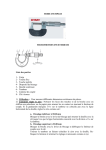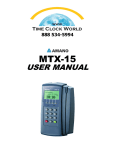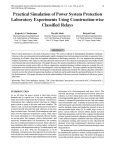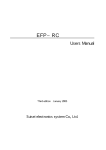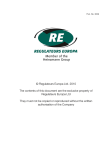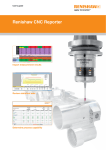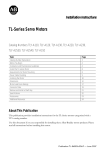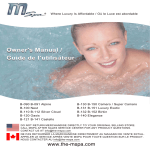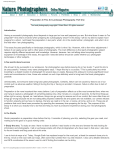Download PUB_3373 - Actuator
Transcript
INSTRUCTION MANUAL FOR OPERATION AND MAINTENANCE OF ACTUATOR CHARGER / TESTER Pub. No. 3373 – Issue 5 © Regulateurs Europa Ltd 2011 The contents of this document are the exclusive property of Regulateurs Europa Ltd They must not be copied or reproduced without the written authorisation of the Company 2 3 INDEX 1 REVISION HISTORY............................................................................................... 5 2 FOREWORD............................................................................................................ 6 3 GENERAL SAFETY ................................................................................................ 7 4 5 3.1 General ........................................................................................................ 7 3.2 Safety Of Personnel ................................................................................... 7 GENERAL ELECTROSTATIC PRECAUTIONS ..................................................... 8 4.1 Electrostatic Devices ................................................................................. 8 4.2 Electrical Interference................................................................................ 8 DESCRIPTION ........................................................................................................ 9 5.1 6 Specification ............................................................................................... 9 PROCEDURES FOR SETTING COIL MAGNET TO CORRECT SENSITIVITY... 10 6.1 Equipment Setup...................................................................................... 10 6.2 Charging the Magnet................................................................................ 10 6.3 Discharging the Magnet........................................................................... 11 6.4 Checking Magnet Sensitivity................................................................... 11 6.5 Reverse Acting Actuator Settings Difference........................................ 11 6.6 Checking for Full Range Capability........................................................ 11 7 MANUAL SWEEP ................................................................................................. 12 8 STEP RESPONSE................................................................................................. 12 9 AUTO RAMP ......................................................................................................... 12 10 RECORDER DRIVE .............................................................................................. 13 11 DRAWINGS ........................................................................................................... 14 12 SERVICE FACILITIES........................................................................................... 17 4 1 REVISION HISTORY Issue 1 2 3 4 5 Date 05.03.96 07.01.97 07.06.00 10.01.03 03.02.11 Name G Nunn M. Birkin 5 Signature 2 FOREWORD These instructions have been compiled to assist personnel responsible for the operation and maintenance of equipment manufactured by Regulateurs Europa Ltd. Care has been taken to ensure that the equipment has been accurately represented, but it should be appreciated that, with the continued progress of design and the diversity of application, certain items may differ in detail. It should be noted that these instructions are issued for general information and do not constitute a specification of the equipment. Whilst reserving the right to make any alteration in design which they may consider advisable the manufacturers absolve themselves from making any such alteration retrospective. In addition to the information given herein, practical advice and assistance are always available from our Customer Support Department. 6 3 GENERAL SAFETY Before carrying out any repairs, adjustments or maintenance to any equipment by Regulateurs Europa Ltd, it is essential the following safety precautions be observed: 3.1 General The equipment may contain one or more of the following: i) ii) iii) iv) v) vi) vii) High voltages Rotating parts High pressure oil Compressed air Preloaded springs PCB’s Microprocessors All of the above items represent a potential danger or hazard to operating personnel and the operator should take care to make himself thoroughly familiar with the operating principles, methods of adjustment and the dismantling and assembly procedures (where applicable) concerning the equipment in his care. 3.2 Safety Of Personnel Before carrying out any repairs, adjustments or maintenance to the equipment or unit, the operator should ensure that any such unit or equipment cannot be activated from a remote position. To achieve this condition, he should ensure that all electrical/pneumatic supplies to the prime mover starter system are isolated at their incoming source and that all electrical supplies to control systems are isolated by the withdrawal of the relevant fuses or by disconnecting the incoming electrical supply at the control board. In addition to these precautions, visual-warning notices should be prominently displayed by the equipment or unit and also at any remote control positions. Where control cabinets and consoles are secured with keys, all such keys should be in the possession of the operator carrying out the work. Information regarding position, level and type of work to be carried out should also be made available to the ‘Engineer in Charge’ of the installation to prevent attempted use of the equipment or unit during breakdown. In the case of electrical/electronic control systems, the operator should make careful reference to the Instruction manual to ensure that he is aware of any special safety precautions which are peculiar to that particular equipment or unit. Before the equipment or unit is finally released for operation, operating personnel should ensure that all tools and repair equipment has been removed and that all safety guards are securely replaced (where applicable). All fuses should be replaced and operating mediums (electrical and pneumatic supplies) should be opened or reconnected. 7 4 GENERAL ELECTROSTATIC PRECAUTIONS 4.1 Electrostatic Devices WARNING! This equipment contains components that are electrostatic sensitive. Electrostatic damage can cause immediate failure or shortening of useful life. Servicing PCBs at component level should be done at an electrostatic free workstation. If site work cannot be avoided, the following precautions must be taken: 4.2 a) All tool tips must be earthed. b) Personal wrist or ankle earth straps must be worn. To protect against personal hazard, the resistance of the earth strap should be approximately 250k ohms. c) PCBs or components should be transported in static free packaging and when removed from packaging laid on static free surface after or prior to assembly. Electrical Interference To avoid possible malfunction of the equipment or infringement of Electrical Interference Regulations, the following precautions must be taken: a) All cable screens to be terminated and earthed at the entry to the equipment b) The equipment to have a low impedance earth c) All doors and covers etc to be firmly secured. 8 5 DESCRIPTION The charger provides means of charging the magnet in the 2200 series actuators by capacitor discharge technique. The correct sensitivity is checked by observing the actuator output movement against a measured change in actuator drive current. A ramp generator is provided to control the actuator current to sweep the actuator output for checking hysteresis. An actuator position transducer is required to drive one axis of an X-Y plotter, a voltage signal is provided from the charger to drive the other axis. 5.1 Specification Power Supply: Nom. 110V or 230V 50/60Hz 40 VA Charge Potential: 280 volts nominal Discharge: As charge but with 100 to 1100 ohms variable limit resistor Test current: 0 to 1 Amp DC Ramp time: Fast, 10 s/cycle Slow, 200 s/cycle X-axis drive: 0 to 1 Volt floating 1 ohm source 9 6 PROCEDURES FOR SETTING COIL MAGNET TO CORRECT SENSITIVITY WARNING! This section will deal with the calibration of a ‘NORMAL’ acting actuator and assumes that the following has been completed first: • In the case of a ‘ballhead backup’ governor/actuator that all mechanical settings have been made. • The ‘Link’ between pins A and B has been removed (plug or terminal block). • Any diode fitted has been removed from the Actuator coil wiring. During this setup procedure the magnet will be fully charged (magnetised) and then discharged in steps. At each stage the sensitivity will be checked for conformity. 6.1 Equipment Setup a) Fit actuator to a test rig that enables the drive shaft to be driven. b) Set up pilot valve lap as described in the actuator user manual. c) Connect actuator to the Actuator Charger/Tester box by means of the 4 pin socket via a suitable terminal to plug adaptor. (Coil wire A=BROWN ~ B=ORANGE ~ C=RED) d) Connect a digital DC ammeter to the red and black ‘METER’ terminals on the front of the Actuator Charger/Tester box. e) Turn on mains power via the switch at the rear of the Actuator Charger/Tester box. 6.2 Charging the Magnet a) Set ‘NORMAL/REV’ switch to ‘NORMAL’. b) Set the ‘CHARGE/DISCHARGE’ switch to the ‘CHARGE’ position. Check that the ‘CHARGE AVAILABLE’ lamp is illuminated. c) Hold down the ‘TEST/CHARGE’ switch in the ‘CHARGE’ position. d) Press down the ‘PULSE’ switch and hold for approximately 3 seconds, then release both switches. During this pulse process the ‘CHARGE AVAILABLE’ lamp will extinguish temporarily. The magnet now has a full magnetic charge. 10 6.3 Discharging the Magnet a) b) c) d) 6.4 Set the ‘CHARGE/DISCHARGE’ switch to ‘DISCHARGE’. Turn the ‘SET DISCHARGE ‘potentiometer to a scale reading of 5.0. Hold down the ‘TEST/CHARGE’ switch in the ‘CHARGE’ position. Press down the ‘PULSE’ switch and hold for approximately 3 seconds, then release both switches. Checking Magnet Sensitivity a) Leave the ‘TEST/CHARGE’ switch in the ‘TEST’ position. b) Set the ‘RAMP/CHARGE-STEP’ switch to ‘STEP’. c) Set the ‘MAX STEP/MIN STEP’ switch to ‘MIN STEP’ and adjust ‘SET STEP MIN’ potentiometer to give a 0.250A reading on the digital ammeter. d) Adjust actuator bias screw to set the output scale to a reading of 2.0 divisions. e) Set ‘MAX STEP/MIN STEP’ switch to ‘MAX STEP’ and adjust ‘SET STEP MAX’ potentiometer to give a 0.750A reading on the digital ammeter. f) Operate ‘MAX STEP/MIN STEP’ switch between ‘MIN’ and ‘MAX’ and observe the output scale readings. (The output scale should read 2.0 divisions at 0.250A and 8.0 divisions at 0.750A.) g) If the magnetic charge is too sensitive (range larger than 6.0 divisions) then turn the ‘SET DISCHARGE’ potentiometer clockwise in small increments and at each increment repeat steps in section 6.3 followed by those in section 6.4. h) Should too much charge have been removed then a full recharge is required. Repeat steps 6.2, 6.3 and 6.4 until correct setting is achieved. 6.5 Reverse Acting Actuator Settings Difference For reverse acting actuators the ‘NORMAL/REV’ switch is set to the ‘REV’ position and the settings are output scale 2.0 divisions = 0.750A and output scale 8.0 divisions = 0.250A. The CHARGE and DISCHARGING of the magnet on a ‘reverse acting’ actuator is done in the same way as the ‘normal acting’ actuator except the different settings need to be observed. 6.6 Checking for Full Range Capability a) Leave the ‘TEST/CHARGE’ switch in the ‘TEST’ position. b) Set the ‘RAMP/CHARGE-STEP’ switch to ‘STEP’. c) Set the ‘MAX STEP/MIN STEP’ switch to ‘MIN’ and adjust ‘SET STEP MIN’ potentiometer to read 0.000A on the digital ammeter. The output scale position should be 0.0 divisions. d) Turn the ‘SET STEP MIN’ potentiometer clockwise to read 1.000A on the digital ammeter. The output scale position should be 10.0 divisions or above. e) Return ‘SET STEP MIN’ potentiometer to read 0.250A on the digital ammeter. f) Turn off mains power via the switch at the rear of the Actuator Charger/Tester box. 11 When all settings are correct the coil leads are to be soldered onto the 4 pin fixed plug ensuring that pins A and B are linked together. After soldering has been completed, reconnect the Actuator Charger/Tester box and confirm settings. The bias screw may need readjusting - this is normal. Note: If any diode has been removed prior to following the above procedures, then it needs to be re-installed before returning the actuator to service. 7 MANUAL SWEEP a) b) c) d) 8 Set the ‘RESET/START’ switch to ‘START’. Set the ‘RAMP/CHARGE STEP’ switch to ‘STEP’. Set the ‘MAX STEP/MIN STEP’ switch to ‘MIN STEP’. Sweep the actuator by manually adjusting the ‘SET STEP MIN’ potentiometer. STEP RESPONSE a) Set the ‘RAMP/CHARGE STEP’ switch to ‘STEP’. b) Set the ‘MAX STEP/MIN STEP’ switch to ‘MIN STEP’ or ‘MAX STEP’. c) If ‘MIN STEP’ was set then the actuator current will be set by the ‘SET STEP MIN’ potentiometer. Likewise, if ‘MAX STEP’ was set then the actuator current will be set by the ‘SET STEP MAX’ potentiometer. Both of the potentiometer settings are adjustable to permit the configuration of the step amplitude. 9 AUTO RAMP a) Set the ‘RAMP/CHARGE STEP’ switch to ‘RAMP’. b) Set the ‘RESET/START’ switch to ‘RESET’. c) Check the ramp amplitude by setting the ‘MAX RAMP/MIN RAMP’ switch to ‘MIN RAMP’ (in which case the actuator current will be set by the ‘SET RAMP MIN’ potentiometer below the analogue gauge), or ‘MAX RAMP’ (in which case the actuator current will be set by the ‘SET RAMP MAX’ potentiometer below the analogue gauge). Both potentiometers can be adjusted to permit the configuration of the ramp amplitude. d) Set the ‘FAST RAMP/SLOW RAMP’ switch to ‘SLOW RAMP’ to enable a slow ramp (suited to most tests). If a fast ramp is required (e.g. for bedding in) then ‘FAST RAMP’ should be set. 12 10 RECORDER DRIVE A 0 to 1 volt signal generated from the actuator current passing through a 1 ohm resistor is available from the red and black ‘X-AXIS’ terminals on the front of the Actuator Charger/Tester box. This can be used to drive an X-Y recorder for hysteresis checking. Set the ‘FAST RAMP / SLOW RAMP’ switch to ‘SLOW RAMP’ for this test. 13 11 DRAWINGS Layout 110V 230V AG818 AG825 14 1 DWG. NO. 2 3 4 5 6 7 8 9 10 AG 818 305 17 280 16 A TEST NORMAL RAMP MAX STEP MAX RAMP FAST RAMP CHARGE REV CHARGE/ STEP MIN STEP MIN RAMP SLOW RAMP RESET CHARGE START DISCHARGE PULSE B 177 ACTUATOR CURRENT SET DISCHARGE 2 30 0 0 90 .4 .6 .8 SET STEP MIN MAX 1 7 80 0 10 .2 0 CHARGE AVAILABLE 5040 60 (LED1) (VR4) (VR5) (VR7) SET RAMP MIN MAX SUPPLY ON (LED2) (VR2) C X-AXIS METER (VR1) (T3) (T4) (T1) (T2) ACTUATOR CHARGER/TESTER NAME PLATE (92G33) TR3 (MOUNTED ON HEATSINK) MOUNTING PLATE (AG 819) FUSED, SWITCHED MAINS SOCKET SK1,FS1,FS2 (110V SUPPLY) D PL3 T2 F PL1 VIEW ON BACK CABLE GLAND (CONNECTIONS TO ACTUATOR) 100 90 80 70 60 50 40 30 1:1 0 PL2 SERIAL No PLATE (62G22) 20 MAGNET CHARGER PCB - P707601 (MOUNTED ON STAND-OFFS M3x13 LONG) 10 T1 E 110 THIRD ANGLE PROJECTION 120 130 PL4 140 150 110V AC SW8 SW9 SW4 SW5 SW1 SW3 SW2 SW7 SCALE A EARTH STUD M6 SW6 FOR CIRCUIT DIAGRAM & PARTS LIST SEE DRAWING L4840 G C SCALE C DRAWN C DATE 3 C 08/05/96 DA 5068 2 C 26/02/96 AS BUILT ISSUE DATE AND COPYRIGHTC VIEW WITH TOP COVER REMOVED It must not be divulged, copied or reproduced without written authorisation of the company. This document is the exclusive property of GEC ALSTHOM Regulateurs Europa Ltd and is strictly confidential. KGS KGS A 1:1 KGS MATERIAL & HEAT TREATMENT CHECKED APPROVED D.A No. INITIALS FILMED DESIGN PRODUCTION GEC ALSTHOM Regulateurs Europa Ltd NOTES APPLICABLE UNLESS STATED OTHERWISE:- ASSY or REF No. SIMILAR T0 DRG No. TITLE INSTALLATION/LAYOUT ACTUATOR CHARGER/TESTER (110V VERSION) 1995 MANUFACTURING INSTRUCTIONS ALL DIMENSIONS IN MILLIMETRES THREADS TO BS 3643 6g 6H. PIPE THREADS TO BS 2779 DIAMETERS ARE SHOWN THUS ø SURFACES MARKED THUS TO BE MACHINED SURFACE TEXTURE CLA VALUES IN MICROMETRES FILMED LATEST ISSUE CANCELS PREVIOUS ISSUES ISSUE No. THUS 5 SHOWS LOCATION OF ALTERATION c THIRD ANGLE PROJECTION 19/2/96 UNTOLERANCED DIMENSIONS TO BE WITHIN ±0.4 GEOMETRICAL TOLERANCES IN ACCORDANCE WITH BS 308 DRAWING NO. AG 818 SHEET OF GEC ALSTHOM, REGULATEURS EUROPA LTD PORT LANE, COLCHESTER. CO1 2NX SHEETS FORM No. A1-FS-MM 1 DWG. NO. 2 3 4 5 6 7 8 9 10 AG 825 305 17 280 16 A TEST NORMAL RAMP MAX STEP MAX RAMP FAST RAMP CHARGE REV CHARGE/ STEP MIN STEP MIN RAMP SLOW RAMP RESET CHARGE START DISCHARGE PULSE B 177 ACTUATOR CURRENT SET DISCHARGE 2 30 0 0 90 .2 .4 .6 .8 SET STEP MIN MAX 1 7 80 0 10 0 CHARGE AVAILABLE 5040 60 (LED1) (VR4) (VR5) (VR7) SET RAMP MIN MAX SUPPLY ON (VR2) (LED2) C X-AXIS METER (VR1) (T3) (T4) (T1) (T2) ACTUATOR CHARGER/TESTER NAME PLATE (92G33) TR3 (MOUNTED ON HEATSINK) MOUNTING PLATE (AG 819) FUSED, SWITCHED MAINS SOCKET SK1,FS1,FS2 (230V SUPPLY) D PL3 T2 F PL1 VIEW ON BACK CABLE GLAND (CONNECTIONS TO ACTUATOR) 100 90 80 70 60 50 40 30 1:1 0 PL2 SERIAL No PLATE (62G22) 20 MAGNET CHARGER PCB - P707601 (MOUNTED ON STAND-OFFS M3x13 LONG) 10 T1 E 110 THIRD ANGLE PROJECTION 120 130 PL4 140 150 230V AC SW8 SW9 SW4 SW5 SW1 SW3 SW2 SW7 SCALE A EARTH STUD M6 SW6 FOR CIRCUIT DIAGRAM & PARTS LIST SEE DRAWING L4995 G ISSUE C SCALE C DRAWN C DATE C CHECKED C FILMED DATE AND D.A No. INITIALS FILMED COPYRIGHT C VIEW WITH TOP COVER REMOVED This document is the exclusive property of GEC ALSTHOM Regulateurs Europa Ltd and is strictly confidential. It must not be divulged, copied or reproduced without written authorisation of the company. A 1:1 KGS APPROVED DESIGN PRODUCTION GEC ALSTHOM Regulateurs Europa Ltd MATERIAL & HEAT TREATMENT NOTES APPLICABLE UNLESS STATED OTHERWISE:- ASSY or REF No. SIMILAR T0 DRG No. TITLE INSTALLATION/LAYOUT ACTUATOR CHARGER/TESTER (230V VERSION) 1995 MANUFACTURING INSTRUCTIONS ALL DIMENSIONS IN MILLIMETRES THREADS TO BS 3643 6g 6H. PIPE THREADS TO BS 2779 DIAMETERS ARE SHOWN THUS ø SURFACES MARKED THUS TO BE MACHINED SURFACE TEXTURE CLA VALUES IN MICROMETRES LATEST ISSUE CANCELS PREVIOUS ISSUES ISSUE No. THUS 5 SHOWS LOCATION OF ALTERATION c THIRD ANGLE PROJECTION 08/XII/97 UNTOLERANCED DIMENSIONS TO BE WITHIN ±0.4 GEOMETRICAL TOLERANCES IN ACCORDANCE WITH BS 308 DRAWING NO. AG 825 SHEET OF GEC ALSTHOM, REGULATEURS EUROPA LTD PORT LANE, COLCHESTER. CO1 2NX SHEETS FORM No. A1-FS-MM 12 SERVICE FACILITIES To ensure prompt and satisfactory attention to customer’s enquiries, all communications should refer to the UNIT TYPE and SERIAL NUMBER, as stamped on the nameplate. In order to obtain the most efficient service it is recommended that all enquiries for service or spare parts to be addressed to the manufacturer of the equipment to which the unit is fitted. Customer training can be provided at Colchester. Contact below for further details. Regulateurs Europa Ltd Port Lane COLCHESTER ESSEX C01 2NX ENGLAND Tel: 44 (0)1206 799556 Fax: 44 (0)1206 792685 17

















